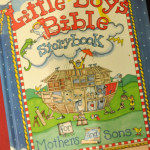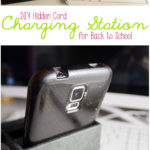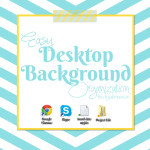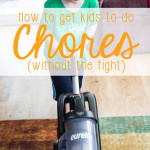One of the biggest questions I get when I tell people about the curriculum I use is, “Yeah, but how do you keep track of it all?” Sometimes, curriculum can get overwhelming, and I’ve heard more than one family lament the “Ugh, I’d love homeschooling a lot more if stuff wasn’t EVERYWHERE!”
While some families are lucky enough to have a school room that is dedicated for collecting all of the pencils, maps, charts, books, and supplies that homeschooling needs, many of us are homeschooling at the kitchen table, and it means it’s a lot harder to stay organized without having books on every surface of your house.
I am by no means an expert, and what works for me may drive you crazy, but since I’ve gotten so many requests, I decided to share with you my particular form of organization.

I’ve found some items have packaging that falls apart after repeated use, but at the same time, it’s important to keep all of those items together. I like to grab a gallon-sized back, put all of the parts to that particular item together, and then include any instructions or parts of the box that include extension activities. This ensures all parts stay together without letting things go missing. In the above picture, I took the suggested activities, and all of the items except the pegs, and put them in the same Ziploc bags. This means when we go to do an activity using this, I can grab this bag and the peg bag and have everything I need handy.
Alternatively, you can also lump like items together in bags. Several separate Lauri Toys that I have come with pegs, and the pegs they come with are all the same– multicolor in the same basic shape. I personally put all of the pegs in the same bag, and just grab the peg bag when we have an activity using pegs.

I’ve found that, for our Preschool-aged curriculum, a rolling cart works very well for storage. I’m able to put our CDs and music-related activities in one drawer, our workbooks in another drawer, our flash cards and activity cards in another, and then have our other activities and craft supplies in other drawers, neatly. Magazine racks on the top store other, larger items that won’t fit in the drawers as easily, like large sheets of tissue paper.

As Zach gets older, we may adapt our system and go away from a rolling cart, but for now, it makes it easiest to sort the individual activties. The rolling cart can be pushed into my pantry and easily rolled out for school time, or I can just grab the items we’re using for that time of day.

We don’t have a designated school space, so we work hard to intentionally add necessary school items into our decor without drawing too much attention to them. Zach’s calendar, for example, is tucked next to his indoor playset, making it look like a part of that area, but still allowing easy everyday access. Another alternative storage solution for the calendar would be to use Zip-Ties to secure it to our rolling cart.

Zach has a reading nook set up in his play area. Because having a reading nook is a necessity for us, we make sure to seamlessly integrate it into our playspace, even if we can’t integrate it into the kitchen where we do school.
I try to make sure that, in letting our school seep into other areas of our home, we aren’t letting it completely take over our lives, either. When school isn’t in session, either for the evening or weekend, school items that aren’t housed in our main decor can be put away easily in the rolling cart.

To give you a peek at another option, my mother uses a different storage system for schooling Jeffrey, in 8th grade. All of his school books that he uses for the current courses are stored spine-up in a filing cabinet. Resources that are larger and don’t fit in the drawer are kept on a separate bookshelf, along with supplies and past books they still refer to. Each night, my mother goes through the next day’s course schedule, grabs the books she needs quickly and easily, and then pulls any larger supplies or curriculum pieces they need from the bookshelf.
At the end of it all, there are a few tips that I have for you:
1. Do what makes sense for your family. What works for me might not work for you. What works for your homeschooling coop might not work for you. What works for that lady you met at that homeschooling convention that one time might not work for you. Find what works for you, and use that method.
2. If homeschooling curriculum is taking over your house, it’s time to purge. If you have a lot of supplies from past years, see if there is a family you can bless with those items, or find a swap site to sell it on or trade for items you need.
3. Homeschooling doesn’t have to involve one set classroom. One of the reasons I love homeschooling is that EVERYWHERE is your classroom. Want to study outside on the porch swing? Do it. Want to study at a coffee shop? Do it. Want to study at the kitchen table? Do it. Want to lay in bed and study? Do it. Don’t feel like you have to have a “classroom” in order to make homeschooling work. You can stay organized and keep your homeschooling unchained, too.
4. Group like items together! One of the easiest ways to lose curriculum pieces is to forget to group it together. By keeping things together that go together, you won’t lose it. You have to choose what grouping makes sense, though. Maybe for you it makes the most sense to store your flash cards with other flash cards to keep them together. Or, maybe you’d prefer grouping all of the history together, and all of the English together. Find a logical grouping, and keep things put together that way.
5. Ziplocs, Rubberbands, and Drawers are your friend! These things help keep items together, help hide the homeschool house takeover, and, while seemingly obvious, are overlooked way too often.
What are your tips for organizing homeschooling curriculum? Share them in the comments below!




